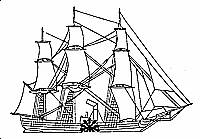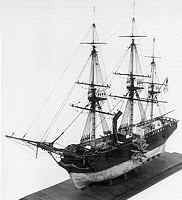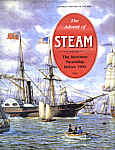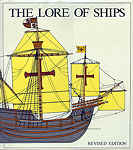
Steamship
Savannah

Picture from The Lore of Ships, Gothenborg 1975.
First ship to cross Atlantic aided by steam
1819
As a Curaçao chauvinist, I cannot really accept this.
The Savannah, a full-rigged sailing ship, may have used a steam engine, but it did not even use it as auxiliary power most of the trip. Her record is not universally accepted. This was in 1819; to put it in perspective, four years after Napoleon's final defeat.
She was built at Corlear's Hook, New York City, in 1818, by Crocker and Ficket. The New York custom house records give her measurements as follows: Tonnage, 319; length, 98.5 feet [30m]; beam, 26 feet [7.95m]; depth of hold, 14.5 feet [4.45m]. The "Savannnah" was equipped with an inclined, direct-acting, low-pressure engine of 90 horse-power. It had a single engine 40 inches [102cm] in diameter, 5 feet [1.5m] stroke; the machinery was built by Stephen Vail at Morristown, N.J., and the boiler by Daniel Dod at Elizabeth, N.J.The Savannah, others say, measured 380 tons, which should mean that the hull below the upper deck had about that volume. The paddle-wheels were detached and stored on deck when under sail.
&8212; Francis B.C. Bradlee, The First Steamer to Cross the Atlantic, Salem 1925
STEAMSHIP CROSSED ATLANTIC
Savannah, GA., November 20, 1819 - The Savannah, the first American Steamship to cross the Atlantic Ocean returned here today after an absence of six months. The Savannah left this port for Liverpool, England on May 22. She arrived in Liverpool on June 20, and went from the[re] to Stockholm, and St. Petersburg, leaving there for her home port on October 10. Moses Rogers of Georgetown, North Carolina piloted the Savannah on its epoch-making voyage.
Enthousiastic crowds, colored and white, lined the banks as the Savannah steamed up the river for which she was named. Here, the quays were crow[d]ed and a great shout went up as the beautiful steamship put on an extra burst of speed as she came in sight of the dock. Smoke poured from her funnel and all hands assembled on deck.
As she slowly moored in, sailors ran aloft and smartly furled the sails on her two main masts and the mizzen. Founded in 1733, taken by the British in 1778, but recaptured three years later, this important cotton shipping port is very proud to have made such an important contribution to American supremacy on the seas.
STEAMSHIP ARRIVES
Liverpool, England, June 20, 1819 - Visionary Yankee ingenuity has stolen a march on British Empire sea leadership and at the same time has blazed the way toward a new means of travel between the Eastern and Western hemisphere.
The steam powered vessel, the Savannah, has arrived at this port from the city of Savannah, Georgia, after a voyage of twenty seven days. This is the first ocean crossing by this type of boat and materially reduces the time formerly required for the Atlantic Ocean voyage.
Her big paddle wheels churning the water and her sails spread, the Yankee vessel made a stirring sight as she entered the harbor. Although originally she had been laid down as a sailing vessel, the Savannah was outfitted with a steam engine. Her engine was used sparingly however, for out of six hundred forty eight hou[r]s on the seas, five hundred sixty hours saw her sail in use.
&8212; News of the Nation December 9, 1823
A bit of Nation building going on here.
Consider that the Savannah used her engine for 88 hours, less than 14% of the time. That cannot have
materially reducedthe travel time. As a matter of fact, the return trip Liverpool-Savannah took over forty days; no wonder as it was sans steam. Compare with Columbus' Second Voyage, departing from Cádiz, Spain, on 25 September 1493. It arrived 3 November in Dominica, after 42 days of which about 10 were spent at the Canary Islands.
Oceangoing Steamships
The first ocean crossing by a steam-propelled vessel was in 1819, when the Savannah voyaged from Savannah, Ga., to Liverpool in 29 days, 11 hr. It was a full-rigged sailing ship fitted with engines and side paddlewheels; during the crossing the engines were in use for about 85 hr. The first crossing under steam power alone was made in 1838, when two British steamship companies sent rival ships to New York within a few days of each other; the Great Western made the trip in 15 days, arriving a few hours after the Sirius, which had left England 4 days before her.
&8212; The Columbia Encyclopedia, Sixth Edition. 2001.
It's hard to figure out even how long the engine actually was used. According to The Oxford Companion to Ships and the Sea, only 8 hours of a total of 21 days. Must be at least one typo. No way they could have burned 100 tons of fuel in only 8 hours:
SHIP
The U.S. ship SAVANNAH, the first steamship to cross the Atlantic (1819), had a dozen sails and used them far more than she did her steam engine, which operated for only 80 hours in a voyage of 27 days.
SAVANNAH steamship
The ship ran under steam for less than 90 hours during the 29-day trip. The 3-masted ship carried 75 tons of coal and 25 cords of wood; all of this fuel was consumed during the crossing.[...]
The advantage that the Savannah's engine gave in calm weather proved insufficient to compensate for the fuel savings of sailing ships.
&8212; Grolier's Toolworks Multimedia Encyclopedia, 1992
According to Bradlee's book, the Savannah was sent to St. Petersburg in the hope that the Russian Tsar would buy it. He didn't. There was an offer by the King of Sweden to buy Savannah for $100,000, which wasn't taken up as he wanted to pay in hemp and iron, but
cash was wanted. The return trip was made under sail as steam was too expensive.

Model of Savannah
from The Advent of Steam
The Bottom Line
The ship had its engine removed and ended its career sailing up and down the Atlantic coast.
Grolier's Toolworks Multimedia Encyclopedia, 1992
     | The Advent of Steam Evolution of the steamship from paddle steamer, to screw-propelled vessel, to intro of marine compound engine in the United States, Europe, and the Far East. Also explained is the introduction of iron construction. Solid on industrial background. |
   |
The Lore of Ships Not much of a sailor myself, I bought this to understand the Hornblower books better. It's a delight. Large format, good info, beautiful. From tree trunks to nuclear submarines. |
     |
Ships and the Sea Lots of reliable info. Maybe a bit heavy on the English side, but after all, it is in English. I know of no equivalent book in any other language anyway. |
SEARCH this site or the Web

copyright notice
all material on this site, except where noted
copyright © by , curaçao
reproduction in any form for any purpose is prohibited
without prior consent in writing